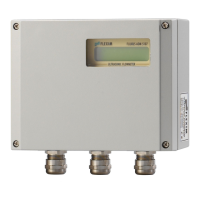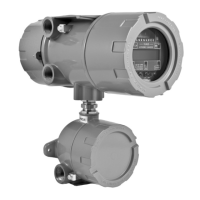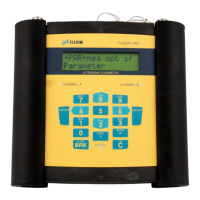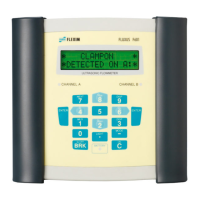Do you have a question about the Flexim FLUXUS ADM 8027 and is the answer not in the manual?
Information about the user manual, handling, and avoiding damages.
Contains instructions marked with specific symbols for safe operation and hazard awareness.
Details FLEXIM's warranty for the product and conditions for its validity.
Instructions for visual inspection upon delivery to check for transport damage and specification conformity.
General care instructions for the precision measuring instrument to ensure proper operation and prevent damage.
Describes the components of the ultrasonic flow measurement system: transmitter, transducers, and pipe.
Explains the TransitTime and NoiseTrek modes for measuring flow velocity based on ultrasonic signals.
Describes the FLUXUS ADM 8027 transmitter with its two housings and terminal locations.
Describes the FLUXUS F801 and ADM 8127B transmitters with their single housing and terminal locations.
Details the functions of the transmitter's 5-key keyboard for navigation and data input.
Explains requirements for acoustic signal propagation through pipe and fluid for accurate measurement.
Discusses the importance of selecting a measuring point away from flow disturbances for accurate results.
Compares different measurement arrangements based on measuring conditions and accuracy.
Guidelines for selecting the measuring point and transmitter location, considering ambient conditions and hazardous areas.
Instructions on how to safely open and close the transmitter housing, emphasizing the set screw.
Details on wall and pipe installation methods for the FLUXUS ADM 8027, including pipe mounting kits.
Important safety notes regarding connections and ensuring the degree of protection of the transmitter.
Recommendations for connecting transducer cables, including preparing and connecting extension cables.
Instructions for connecting the power supply, including safety precautions for hazardous areas.
Details on connecting the RS232 interface, noting it must be done outside explosive atmospheres.
Explains the sensor module's role and the requirement for identical serial numbers with transducers.
Guidelines for selecting the measuring point and transmitter location, considering ambient conditions and hazardous areas.
Instructions on opening and closing the transmitter housing, emphasizing the countersunk screw.
Details on wall and pipe installation for the FLUXUS F801, including pipe mounting kits.
Safety notes on connections and ensuring the transmitter's degree of protection.
Recommendations for connecting transducer cables, including preparing and connecting extension cables.
Instructions for connecting the power supply, including safety precautions for hazardous areas.
Details on connecting the RS232 interface, noting it must be done outside explosive atmospheres.
Explains the sensor module's role and the requirement for identical serial numbers with transducers.
Guidelines for selecting the measuring point and transmitter location, considering ambient conditions and hazardous areas.
Instructions on opening and closing the transmitter housing, emphasizing the countersunk screw.
Details on wall and pipe installation for the ADM 8127B, including pipe mounting kits.
Safety notes on connections and ensuring the transmitter's degree of protection.
Specific instructions for connecting transducers for mine applications, including explosion protection measures.
Instructions for connecting the power supply, including safety precautions for hazardous areas and ATEX compliance.
Steps to prepare the pipe surface for transducer mounting, ensuring good acoustic contact.
Guidelines for transducer orientation and setting the correct distance between them for accurate measurement.
Details on using the Variofix L fixture for mounting transducers in reflection and diagonal arrangements.
Step-by-step guide for installing transducers into the Variofix L fixture and on the pipe.
Details on using the Variofix C fixture for mounting transducers in reflection and diagonal arrangements.
Step-by-step guide for installing transducers into the Variofix C fixture and on the pipe.
Specific instructions for mounting transducers using FLEXIM clasps for mine applications.
Describes the initial display upon powering up the transmitter and the unavailability of data entry.
Procedures for initializing the transmitter, including factory default reset options for settings and measured values.
Explains the main menu structure and how to navigate between program branches using keys.
Overviews of the main program branches: Parameter, Measuring, Output Options, and Special Functions.
Lists key sequences (HotCodes) for activating specific functions and settings, with cross-references.
Details how to select the operating language of the transmitter using HotCodes.
Describes transmitter behavior during power interruptions and after power restoration, noting data saving.
Guides on entering pipe diameter, wall thickness, and material parameters for accurate measurement.
Explains how to specify pipe lining material and its sound speed for the measurement.
Details on entering pipe roughness, which influences flow profile correction.
Guides on entering fluid properties like sound speed, viscosity, density, temperature, and pressure.
Covers transducer parameters and extension cable length inputs.
Instructions on activating or deactivating measurement channels and entering measuring point numbers.
Setting the number of sound paths based on transducers and parameters.
Guidance on adjusting the transducer distance for optimal measurement.
Steps for fine-tuning transducer distance using signal amplitude and quality indicators.
Details on starting the measurement process, including multiplexer operation and output updates.
Explains how to detect flow direction using volumetric flow rate and transducer arrow orientation.
Guides on selecting measured physical quantities (flow velocity, volumetric flow, mass flow) and their units.
Explains display modes (AutoMux, HumanMux) for viewing measured values from multiple channels.
How to customize the display to show one or two measured values, including status line information.
Explains the information displayed in the status line, indicating signal quality, sound speed, flow profile, and flow velocity.
How the optimum and entered transducer distances are displayed and compensated for.
Lists executable commands during measurement, such as adjusting transducers or clearing totalizers.
Explains how to set the damping factor for averaging measured values and its effect on signal fluctuations.
Describes the function of totalizers for summing flow volumes or masses in both directions.
Configuration settings for the HybridTrek mode, enabling automatic toggling between TransitTime and NoiseTrek.
How to set an upper limit for flow velocity to ignore outliers and mark invalid values.
Setting a lower limit (cut-off flow) for flow velocity, below which values are set to zero.
Explanation of the FastFood mode for measuring flows with high dynamics and its limitations.
Introduction to virtual calculation channels for deriving values from other channels.
How to change the lower limit of the inner pipe diameter for specific transducer types.
Overview of the data logger's function, stored data types, and activation.
How to activate or deactivate the data logger for storing measured data.
Setting the frequency for storing or transmitting measured values per channel.
Information on transmitting measured data to a PC via serial interface (RS232/RS485).
How to transmit data in real-time during measurement using a terminal program.
Procedures for transmitting logged data from the device to a PC.
Step-by-step guide for using the FluxData software to transfer logged data from the transmitter.
How to divide the coefficient memory for storing material and fluid parameters.
Introduction to the extended library for entering temperature/pressure-dependent material/fluid properties.
Procedure for deleting user-defined materials or fluids from the transmitter's memory.
How to arrange material and fluid lists displayed in the Parameter branch.
How to set the transmitter's internal clock for accurate date and time stamping of measurements.
Configuration of dialogs and menus, including pipe circumference setting.
How to select between user-entered or auto-detected transducer distance.
Setting the delay before transmitting an error value when no valid measurement is available.
Setting units for length, temperature, pressure, density, viscosity, and sound speed.
Various measurement settings including sound speed comparison, flow velocity correction, cut-off flow, and turbulence mode.
How to activate and deactivate the SuperUser mode for advanced analysis and parameter definition.
Setting flow parameters like profile bounds and flow velocity correction in SuperUser mode.
Setting a maximum signal amplification limit to prevent false readings from noise.
Defining the upper limit for sound speed to evaluate signal plausibility.
Steps to install and assign outputs, including source channel and physical quantity.
How to activate analog outputs after installation and configure their measuring range.
Configuring a frequency output to act as a pulse output for totalization.
Configuring a binary output to function as a pulse output for integrating fluid quantities.
Activating binary outputs as alarm outputs to signal measurement events.
Setting high and low limits for alarm outputs based on measured values or totalizers.
Explains how alarm outputs behave under different conditions, including switching delay.
Procedures for deactivating configured outputs, with stored configurations remaining available.
Information on calibration, its necessity, and when re-calibration is recommended.
Troubleshooting steps for display issues, including contrast and power supply checks.
Addresses issues with no signal reception, including parameter checks, transducer distance, and acoustic contact.
Guidelines for selecting an appropriate measuring point, avoiding disturbances and ensuring proper conditions.
Explains causes for large deviations, such as wrong sound speed, gas in pipe, or incorrect limits.
Troubleshooting steps for totalizer issues like values being too high, too small, or incorrect sums.
Details the menu structure within the Parameter branch for inputting pipe and fluid properties.
Lists available units of measurement for length and roughness.
Lists available units of measurement for temperature (°C, °F).
Lists available units of measurement for pressure (bar, psi, absolute/relative).
Lists available units of measurement for density (g/cm³, kg/cm³).
Lists available units of measurement for sound speed (m/s).
Lists available units of measurement for kinematic viscosity (mm²/s, cSt).
Lists available units of measurement for flow velocity (m/s, cm/s, in/s, fps).
Lists available units for volumetric flow rate and its totalized values.
Lists available units for mass flow rate and its totalized values.
Table listing sound speeds for various pipe and lining materials at 20°C.
Instructions for cleaning the transmitter and transducers, including removing acoustic coupling compound.
Guidance on checking O-rings in flameproof and increased safety housings and their replacement.
| Accuracy | ±0.5% of reading ±0.01 m/s |
|---|---|
| Protection Class (Transmitter) | IP 65 |
| Display | Graphical LCD |
| Measurement Principle | Ultrasonic |
| Fluid Types | Liquids |
| Pipe Sizes | DN 15 to DN 6000 |
| Measurement Range | 0.01 ... 25 m/s |
| Flow Velocity Range | 0.01 ... 25 m/s |
| Temperature Range (Transducers) | -40°C ... +200°C |
| Outputs | 4-20 mA, pulse, frequency, relay |
| Communication Interfaces | HART, Modbus |
| Power Supply | 24 V DC, 100-240 V AC |
| Temperature Range | -40°C ... +600°C (depending on transducer) |



